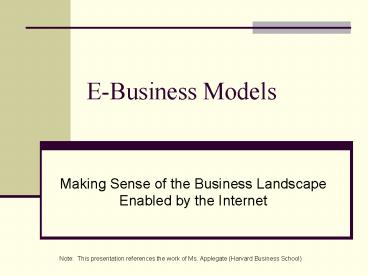EBusiness Models - PowerPoint PPT Presentation
1 / 16
Title:
EBusiness Models
Description:
Transaction that may (does not have to) lead to the delivery of a ... Flow of associated info and funds. eTrade. Supplier to supplier transactions. eBusiness ... – PowerPoint PPT presentation
Number of Views:63
Avg rating:3.0/5.0
Title: EBusiness Models
1
E-Business Models
- Making Sense of the Business Landscape Enabled by
the Internet
Note This presentation references the work of
Ms. Applegate (Harvard Business School)
2
Overview
- eBusiness defined
- Models and their properties
- Classification of Network Business Models
- Business model evolution
- E-Business Models Lessons from the field
3
eBusiness
- Gateway to a deal
- Transaction that may (does not have to) lead to
the delivery of a physical product or service - eCommerce
- Buying/selling of goods
- Flow of associated info and funds
- eTrade
- Supplier to supplier transactions
4
eBusiness
- Technical aspects
- Hardware, software, networks
- Connects a community of interest
- Enables exchange of information
- Business models
- How businesses interwork
- How this influences the way the are established
and the ways IT is deployed
5
Technology Capabilities(Traditional vs. Internet)
- Closed standards
- limit participation to those with access to
proprietary software - Proprietary ownership of the platform
- owner sets commerce standards/policies
- Rigid design
- limits business functionality/flexibility
- High cost, long time frame, specialized expertise
to develop business solutions - barriers to conducting business
- Open standards
- Global connectivity to anyone with a browser and
Internet access - Shared ownership of the network
- Commerce is defined and managed through
collaborative relationships - Modular, flexible software and infrastructure
- Enables business flexibility
- Lower cost, shorter time frame to develop
business solutions - Enables new business opportunities
6
Industrial vs. Networked Economy
- Harnessing the power of Internet requires the
invention of new models - Industrial Economy models may no longer be viable
in the Networked Economy - Best inventions built off old paradigms
- Components and relationships are not new
- Rules and assumptions that guide decision making
and action taking steps are new
7
Industrial vs. Networked Economy Models
- Vertically integrated
- Built to manage complexity by minimizing it
- Standardized products to mass markets
- Standardized, highly specialized jobs
- Assembly-line model
- Supplier processes - distributors
- Vertical/horizontal integration
- Use of IT to exploit complexity
- Highly customized, personalized products/services
- Teams of experts (inside/outside) innovate
- Digital business infrastructure
- Streamline operations
- Complex tasks performed anytime/anywhere
- Real time data for self-learning and adopting
8
Networked Economy Assumptions
- The distinct separation between producers of IT
(e.g., IBM, Intuit, Microsoft) and the business
that use IT as a core component of their strategy
and operations (e.g., FedEx, Charles Schwab) is
going away. - Dot-com businesses are starting to look and act a
lot like established brick-and-mortar companies
and vise-versa - Seamless transition between the online and
offline worlds is the key
9
Networked Economy Assumptions
- Shift of gravity of firms economic resources
from tangible assets (property, inventory,
plants, equipment) to intangible assets - Goodwill
- Intellectual property
- Relationships
- Knowledge and expertise
- Agility and responsiveness
- Strengths of brand
10
Models and Their Properties
- What is a model?
- Physical world
- A small object built to scale represents a
larger, more complex object - Business world
- Succinct description of a complex business
11
Model Properties
- What are the properties of models?
- Enable study of
- business structure, relationship between
structural elements and how it will respond in
the real world - Can be built before the real system to help
predict systems behavior if structure,
relationship and assumptions change - Provide a baseline for evaluation progress
12
Classifying Network Business Models
- Value chain roles
- Producers vs. Distributors
- Digital businesses vs. digital infrastructure
providers
13
Value Chain Roles
- Producers
- Design/build products/services
- May function as suppliers to other businesses
- Parts/components/services
- May function as OEMs
- Distributors
- Enable transaction stakeholders to
- Connect, communication and complete business
transactions
14
Digital Business Models - Distributors
- Focused Distributors vs. Portals
- Focused Distributors
- Provide products and services related to a
specific industry or market niche - Portals
- Early portals gateways to web content and tools
(e.g., CompuServe, Netscape, AOL) - Destination for shopping, learning, conducting
business
15
Digital Business Models
- Differentiating factors
- Producers
- Focused Distributors
- Portals
16
E-Business Models Lessons from the field1
- Successful e-businesses shape and are shaped by
customers and the business community - New e-business models are emerging through the
process of evolution and adaptation - Value webs are replacing value chains
1 Source IT and the Future Enterprise by
Dickson and DeSanctis, Prentice Hall, 2000

